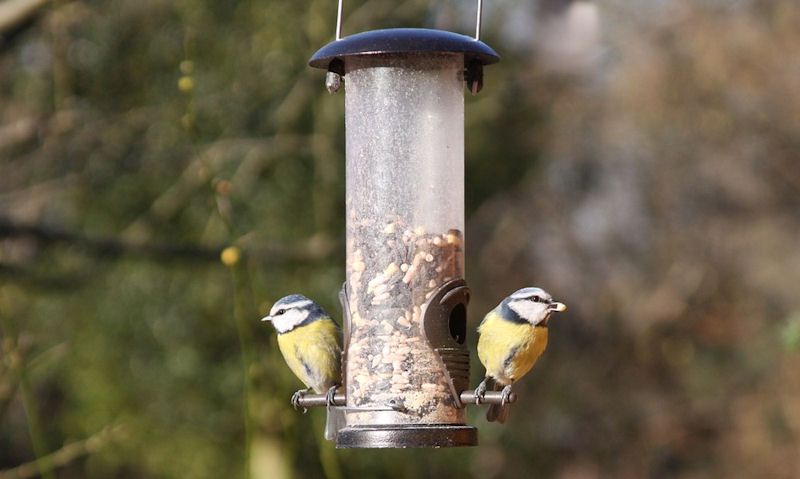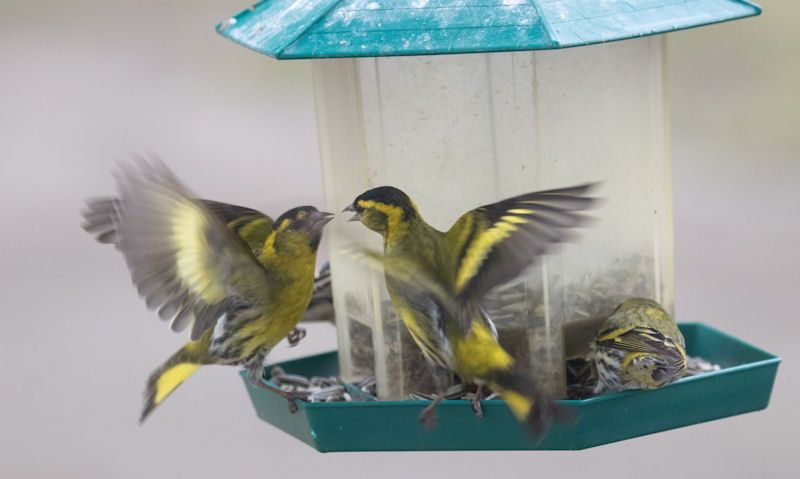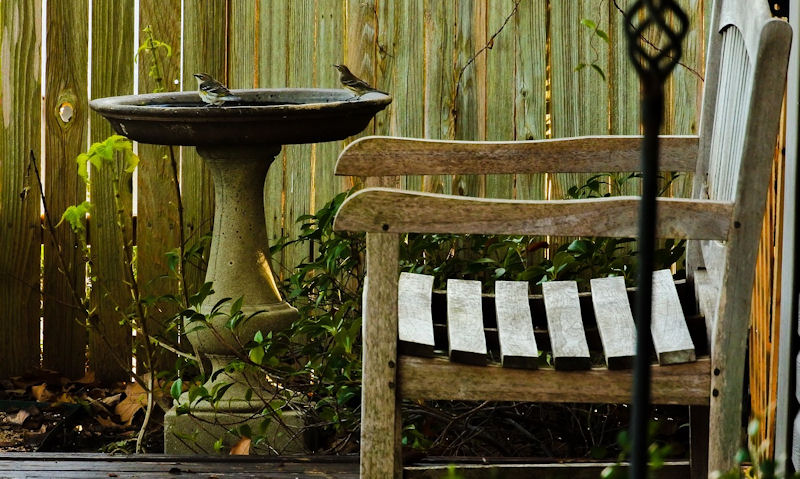How to fill a bird feeder
How you fill up a bird feeder would first require knowing how to open the awkward things, then its a matter of using the correct amount of bird feed, as to not let it go to waste.
How to fill a bird feeder requires opening the lid from a simple lift up action, to the rarely used screw top lid. Opening a squirrel proof feeder has its problems, but not impossible as it opens still fixed to the guard, or you'll need to remove the feeder. Only fill up feeders half to reduce waste.
If we're talking about how to access all common bird feeder types, then you only need to lift up the lid that slides up on what's known as the hook.
That hook is what hangs up on the bracket or tree branch, but its also used to connect the lid to allow easy access for filling feeders up with all types of bird feed.
However, if you want to know how to fill up a feeder with the correct amount a feed, then remember the less used, the less goes to waste.
So the easy solution to this is only fill a bird feeder a quarter at first, before moving onto a third, a half or two-thirds... but never fill it up all the way.
Not only do you need to allow a little breathing space for the feed, but it will also be more manageable as to prevent spillage when you do fill it up.
Simple left up lid on hoop
If you're in ownership of any kind of Gardman bird feeder; it be a peanut, seed or fat ball feeder, chances are its the lift up lid kind.
Well its not exclusive to the Gardman feeder design, its a feature that is present in most others, including ChapelWood, RSPB and Peckish feeder.
And as its a simple lift lid, there's no lock or screw to deal with, just pull it up.
This lid, regardless of size or shape, is permanently fixed to the feeder well it slides up and down on the hook, which can also be used as an handle for carrying.
So to lift up Gardman lids, the hook must be pointing up in a 90 degree angle, so's to lift the lid up well the hook is upright.
Its designed like this to allow people to fill up the feeder with ease, it is also designed to be made a little awkward to open for visiting wild birds.
This will in turn prevent clever squirrels accessing peanut feeder or the clever crow gaining access to all the feed within the seed tube, or peanut mesh feeder.
When the hook is folded down with no room above to pull up the lid, its not secured there so you only need to lift up hook/lid in one to pulled them up together.
Rarely a screw top
One vital yet simple solution to opening basic bird feeders of all kind would be making use of the screw top.
But that option is rarely used for three simple reasons:
- Out in the elements the materials the feeder is made from can shrink or expand, thus making the top difficult to open
- When not cleaned regularly the feed contained within the feeder will eventually stick around the screw top rim, making it hard to open or close
- Its not convenient, and for many people its would be hard to open a screw top that was previously closed tight by someone before them
Well it mostly applies to structures made from wood, shrinking or expanding in cold or hot weather is not an uncommon thing in metal or plastic.
So that would result in huge problems for you; if the feeder lid shrinks or expands, either way you won't be able to close or open the lid so easy.
Use of screw top outside where bird feed is concerned as it own problems.
Amongst them, lack of maintenance and cleaning of feeders is one thing, but when the area around the screw top is not removed of built up, dried food, there's no opening it.
Thankfully, manufacturer's know this so don't supply many feeders with the screw top design, instead choosing to use the simple lift up lid mechanism.
Pop off lid kind
As it happens you won't need to lift up or unscrew the lid at all if its a cheap plastic bird feeder with a pull off lid.
Manufacturer's take advantage of the durable plastic construction by making it a pop on, pop off lid.
There would usually be one or two lips that are designed for you to get your fingers under to lift up, but there's really no guarantee it will stay closed under heavy weight.
What we mean by that is, using a pop on lid its usually fixed to the hook, so if the lid fails on you, that will in turn result in the feeder - and its load - dropping to the ground.
Make no mistake, we call them cheaper feeders as they're made from plastic, but it still would be possible to buy such feeders from well known brands.
Fill up squirrel proof feeder
Squirrel proof bird feeders bring there own lid design to the range, as to accommodate the feeder that is fixed to the middle of the squirrel proof guard/cage.
And well half will make use of the lift up lid, others will require you to remove the feeder from the squirrel cage before you can top up the feeder through the lid.
Well squirrel proof feeders have lids, some don't make use of them at all.
So how do you fill a squirrel proof bird feeder for bird feed including peanut, seeds, fat balls or suet blocks.
Regardless of design, it should be a simple task.
Gardman squirrel proof feeders inherit the design on their bird feeder range with a lift up lid with usually a knob on top.
That way the feeder fixed to the centre of the cage stays put, so no need to remove it.
Its also possible to use there squirrel proof feeder that you unlock the cage surround, to take off the top half, which will in turn remove the section to the feeder so you can refill.
Not a lock features, but more a unclip and clip-on mechanism.
Well we've mostly focused on how to fill Gardman feeders here, the design is usually present all other brands, so no need to explain further as its all similar lid functionality.
Only fill up half way or two-thirds
Now that you know how to open most commonly available bird feeders for hanging up in your garden, let's talk feed quantity.
Common practice among garden bird lovers is to fill up peanut or seed feeders all the way to the top.
Don't do this as you need a little space in the feeders as to let the feed breath in the drawn out hot summer months.
That will only apply to the peanut feeder and especially the seed feeder that are always contained within hot, plastic clear tubes.
And as the hot weather will quickly rot the food on the feeders more in the summer than the rest of the year, only fill up the feeders to what you know they will eat on the day.
If fat balls or suet are present then the peanuts or seeds may get used less for some people, and if they're not getting eaten, they will rot.
That doesn't apply to the hot weather either, if its not getting used over the colder months it will still rot inside the mesh cage, or plastic tube especially.
Summary
Well it mostly refers to seed or peanut feeders, when shopping for your next feeder only go for the lift up lid kind.
That way there's no awkward screw top or the more unsafe pop off plastic lid that could result in both feeder and food contained within dropping to the ground.
It gets a little complicated accessing the bird feeder that is fixed to a squirrel proof guard, but with a little practice you'll soon figure it out.
Accessing squirrel proof feeders through the lid happens in two ways; lift up the cage top to access the feeder interior - as to then fill it up with feed, or...
You'd need to remove the feeder from cage to fill it up.
Once you've mastered the opening of all your bird feeders, its then time to fill it up.
And don't just fill it to the top right out of the bat, allow time to pass as to allow you to understand the garden birds feeding habits.
In due course, you'll understand what feed they like best and want kind they leave alone.
Try to fill each feeder only a little way up as to not risk wasting peanuts or seeds, then top it up higher if its popular, or use less if its untouched.
In the end, you'd want to never fill bird feeders to the top so there's a gap between feed and lid, to prevent spillage.
Remarkably, bird feed needs to breath, so a little gap should help with that. This will only apply to those plastic clear tube feeders for use with seed mixes.


